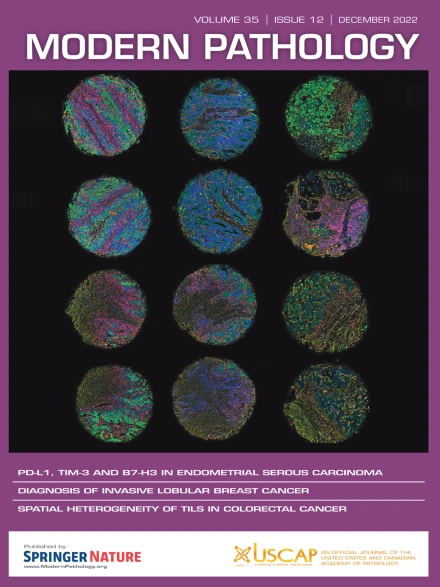Whole Slide Imaging-Free Supporting Tool for Cytotechnologists in Cervical Cytology
IF 5.5
1区 医学
Q1 PATHOLOGY
引用次数: 0
Abstract
Cervical cytology is a crucial method for detecting cancerous and precancerous lesions. However, traditional workflows rely heavily on manual microscopic observations by cytotechnologists, making the process time-consuming and labor-intensive. Although several artificial intelligence (AI)-assisted cytology systems have been developed, most approaches require whole slide images, which entails costly scanning equipment, extensive data storage, and additional processing time. These factors hinder real-time diagnosis and are often impractical in resource-limited settings. In this study, we developed cytology-all-in-one (CYTOLONE), a novel AI model designed to support cytotechnologists in cervical cytology. CYTOLONE was constructed using a model based on OpenAI’s contrastive language-image pretraining framework and fine-tuned using a hierarchical labeling structure. This approach enabled the model to effectively learn the relationship between low-magnification images and cytologic features. By integrating the microscope directly with an Apple Silicon Mac and using an iPhone camera for image capture, CYTOLONE offers real-time evaluation, processing each image in under 0.5 seconds. The evaluation results demonstrated that CYTOLONE achieved superior classification accuracy compared with both contrastive language-image pretraining-ViT-B/16 and GynAIe-B16-10k. The model maintained high Anomaly detection accuracy (95.8%) and significantly improved accuracy in Malignancy (92.8%), Bethesda (61.5%), and Diagnosis (57.5%) categories. Furthermore, feature space visualization revealed clearer boundaries between diagnostic categories, reflecting CYTOLONE’s improved performance. The proposed workflow seamlessly integrates traditional cytology practices, allowing cytotechnologists to receive AI support during real-time specimen observation. This innovative workflow eliminates the need for costly whole slide image scanners, improves diagnostic efficiency, and is well-suited for resource-limited environments. Our findings suggest that CYTOLONE can enhance the efficiency of cytotechnologists and improve diagnostic accuracy, offering a practical solution to the existing limitations in AI-assisted cytology systems.
为宫颈细胞学细胞技术人员提供的全切片无成像支持工具。
宫颈细胞学检查是检测癌和癌前病变的重要方法。然而,传统的工作流程严重依赖于细胞技术人员的手工显微观察,这使得该过程既耗时又费力。虽然已经开发了几种人工智能辅助细胞学系统,但大多数方法需要整个幻灯片图像(wsi),这需要昂贵的扫描设备,大量的数据存储和额外的处理时间。这些因素阻碍了实时诊断,并且在资源有限的环境中往往不切实际。在这项研究中,我们开发了细胞学一体化(CYTOLONE),这是一种新的人工智能模型,旨在支持细胞技术人员进行宫颈细胞学检查。CYTOLONE使用基于OpenAI的对比语言图像预训练(CLIP)框架的模型构建,并使用分层标签结构进行微调。这种方法使模型能够有效地学习低倍率图像与细胞学特征之间的关系。通过将显微镜直接与苹果硅Mac集成,并使用iPhone相机进行图像捕获,CYTOLONE提供实时评估,在0.5秒内处理每张图像。评价结果表明,与clip - viti - b /16和GynAIe-B16-10k相比,CYTOLONE的分类精度更高。该模型保持了较高的异常检测准确率(95.8%),在恶性肿瘤(92.8%)、Bethesda(61.5%)和诊断(57.5%)类别的准确率显著提高。此外,特征空间可视化揭示了诊断类别之间更清晰的界限,反映了CYTOLONE的性能改进。所提出的工作流程无缝集成了传统细胞学实践,使细胞技术人员能够在实时标本观察期间获得人工智能支持。这种创新的工作流程消除了对昂贵的全幻灯片图像(WSI)扫描仪的需求,提高了诊断效率,非常适合资源有限的环境。我们的研究结果表明,CYTOLONE可以提高细胞技术人员的效率,提高诊断的准确性,为人工智能辅助细胞学系统的现有局限性提供了一个实用的解决方案。
本文章由计算机程序翻译,如有差异,请以英文原文为准。
求助全文
约1分钟内获得全文
求助全文
来源期刊

Modern Pathology
医学-病理学
CiteScore
14.30
自引率
2.70%
发文量
174
审稿时长
18 days
期刊介绍:
Modern Pathology, an international journal under the ownership of The United States & Canadian Academy of Pathology (USCAP), serves as an authoritative platform for publishing top-tier clinical and translational research studies in pathology.
Original manuscripts are the primary focus of Modern Pathology, complemented by impactful editorials, reviews, and practice guidelines covering all facets of precision diagnostics in human pathology. The journal's scope includes advancements in molecular diagnostics and genomic classifications of diseases, breakthroughs in immune-oncology, computational science, applied bioinformatics, and digital pathology.
 求助内容:
求助内容: 应助结果提醒方式:
应助结果提醒方式:


